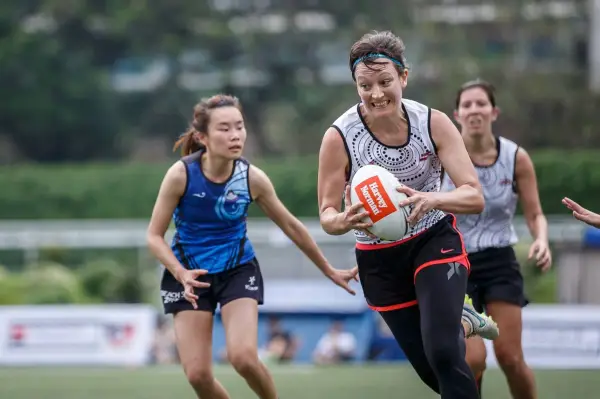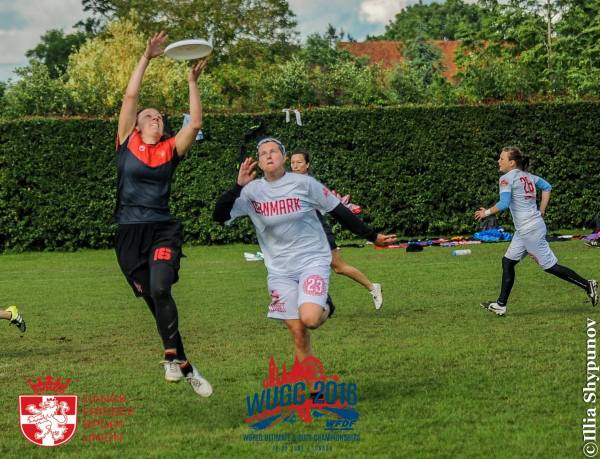Donna Gee — Ultimate Frisbee + Touch & Tag Rugby player, design technology teacher — sharing her perspectives on the parallels between coaching / captaining and teaching

Design technology teacher hailing from Australia, Donna is a multi-sport athlete having represented Hong Kong in both Touch Rugby and Ultimate Frisbee. She’s been playing touch rugby for over 20 years and Ultimate Frisbee for 7 years. By day she heads up the design faculty at Po Leung Kuk Choi Kai Yau School, and 3 – 4 nights a week plus almost every weekend she’s at practice for her sports or at a tournament. She’s also one of the captains for a mixed-gender Ultimate Frisbee team, Junk, in Hong Kong. When she’s not teaching, grading, writing reports, captaining or playing sports, Donna enjoys exhibitions, live music, hiking and the beach.
Having played competitive touch rugby for a long time, why did you choose to take up a second sport competitively? What are some of the additional benefits and challenges of adding a second sport in your life?
I have always trained in several sports simultaneously. In Australia when competing in touch rugby I would play volleyball, surf, snowboard and train for long distance running. In London, I trained in indoor football, capoeira, swimming and finally competed in the London marathon. In Hong Kong, I gave dragon boating a try alongside  touch rugby and then started hearing a bit about this sport Ultimate Frisbee that I had seen at a few university events when I lived in Australia. Keeping the variety of trainings helps to vary both the range of skills and strategies. It also brings about new hurdles as well as coping mechanisms. It reduces complacency, keeps me fit, though it eats into my time… There are occasions where hard decisions are made and priorities flexed. Sometimes it is impossible to do everything but it is fun to try. The skills and fitness from two very complementary sports is advantageous on the competitive field. Speed, agility, endurance, coordination, footwork and spatial sense all work across both sports. Not to mention the amazing people I get to meet and spar up against.
touch rugby and then started hearing a bit about this sport Ultimate Frisbee that I had seen at a few university events when I lived in Australia. Keeping the variety of trainings helps to vary both the range of skills and strategies. It also brings about new hurdles as well as coping mechanisms. It reduces complacency, keeps me fit, though it eats into my time… There are occasions where hard decisions are made and priorities flexed. Sometimes it is impossible to do everything but it is fun to try. The skills and fitness from two very complementary sports is advantageous on the competitive field. Speed, agility, endurance, coordination, footwork and spatial sense all work across both sports. Not to mention the amazing people I get to meet and spar up against.
As a captain of a mixed-gender sports team, what parallels do you draw from captaining to teaching? How do they complement each other for you?
I think both require patience and a positive approach. Both have ups and downs. Both have hidden barriers that I have needed to work through at different stages. I aim to be patient when things get more difficult – it may be that stressful week at work or that game that isn’t going so well. Remembering what you can achieve in one area helps transfer into confidence and success in the other. Being a young female, Design Technology head of department and female athlete within usually mixed gender sports sometimes the biggest barrier is my own self talk. I use the support system not just from my direct network but also from those relationships formed from the leadership positions in sports and profession which promote more positive strength and vision.
You can be the best when you can be a role model as well as a sponge. If you play hard and work hard then you will inspire others to do the same. Discussions may require you to listen from an unbiased standpoint and soak up what is needed. Both have important roles to be played, though one is more active and the other is more passive. Within both I have found it is important to always keep sight of my own principles whether on the field or in the classroom.
How do your sporting endeavors influence the way you behave as a teacher and vice versa?
In sports and teaching I aim to be caring, passionate, enthusiastic, responsible and competitive. Whether it is my lessons, or training sessions or tournament games, I want them to be well prepared, fun and energetic. Reflecting on my own points of learning, I hope to reach to others in positive ways. My most enjoyable sporting sessions are when I can take on new knowledge and be challenged yet supported. I hope that I manage to create similar experiences within my classroom and on the sports field. In both the classroom and the playing field, I have found that people are most involved and the best outcomes achieved when you are considerate and respectful of their actions and responses. More recently, a term – “Spirit of the Game” — from Ultimate Frisbee comes to mind in my teaching ethos: to share and communicate in reasonable ways, to be spirited so that those around you are treated justly, and to reflect and improve on each experience.
can take on new knowledge and be challenged yet supported. I hope that I manage to create similar experiences within my classroom and on the sports field. In both the classroom and the playing field, I have found that people are most involved and the best outcomes achieved when you are considerate and respectful of their actions and responses. More recently, a term – “Spirit of the Game” — from Ultimate Frisbee comes to mind in my teaching ethos: to share and communicate in reasonable ways, to be spirited so that those around you are treated justly, and to reflect and improve on each experience.
From working with your students, do you see differences in attitudes and academic achievements between those who play sports and those who don’t? If there are noticeable differences, what are they?
Students that I have seen really commit to sporting endeavours have also shown many characteristics for academic successes. I would say this doesn’t stop just at sports, it’s those students I see showing initiative and leadership in activities outside of academic areas that seem to have better coping mechanisms within the more formal aspects of education. Some of these areas have been attributed to artistic and musical performances, leadership groups, debates, cultural programs and trips. At the same time, it can’t be denied that sporting teams and competitions play a vital role here. Across the board in all sports, you can see individuals working through challenges, stress, dedication, focus, determination, expectation, physical and mental toughness. The more opportunities there are for students to learn from these situations, the more opportunities these skills transfer positively into formal academic studies.
WISE HK ran a survey in January 2017 where some of our under 18-year old girls responded that lack of role models are a challenge when it comes to sports participation. As a teacher who plays multiple sports, what do you see are ways we can encourage other educators and more parents to become role models themselves when it comes to encouraging our under 18s to play and stay in sports? Moreover, how do you suggest we – the broader community, as stakeholders in the future of all our youth — take action to encourage higher levels of sports participation for our youth?
Building a sporting culture within a school helps to encourage students, teachers and parents’ enthusiasm for sport. School activities that promote sport and everyone’s involvement as players or supporters are always great.
Speaking from my own experience, I grew up in a school where well-known athletes became known members of the school community through talks, specialist training programs, performances and highlighted tournaments. It helped build the prestige of  sport. My school organizing community events built up around competitive sports further promoted this feeling of team spirit. I remember spending many lunch times and after school hours cheering on school mates, seeing juniors chanting for the seniors and then everyone heading out to spectate and support some of the bigger weekend sports matches. School advertisements of meaningful events, teachers reminiscing those unbelievable achievements by local and international athletes, parents taking kids to sporting matches on the weekend and sharing these experiences … these things all count. Sometimes the best role model can be an avid fan.
sport. My school organizing community events built up around competitive sports further promoted this feeling of team spirit. I remember spending many lunch times and after school hours cheering on school mates, seeing juniors chanting for the seniors and then everyone heading out to spectate and support some of the bigger weekend sports matches. School advertisements of meaningful events, teachers reminiscing those unbelievable achievements by local and international athletes, parents taking kids to sporting matches on the weekend and sharing these experiences … these things all count. Sometimes the best role model can be an avid fan.
I think my students thrive on the experiences where our teachers get involved in the action, such as the parent and teacher sprint at the athletics carnival, and the charity teacher basketball match. One of my favourite occasions in the year is to take our students to the Hong Kong Rugby 7s competition, which is arguably the biggest annual sporting event with some of Hong Kong’s most physical and talented athletes. It felt great to be able to be able to point out the Hong Kong women’s team that had just represented at the Rio Olympic Games in 2016 and more of the professional athletes in our city. I always want students to know that it is an achievable goal if they work hard at it. These athletes should be their role models not just for sport but also for their successes in balancing competition and life. This year we had 60 students attend Rugby 7s.
I also think we need to offer a wider variety of sports at schools, and give a larger number of students the chance to find a sport that they truly identify with. It’s important to promote sports for all. We can do more to connect schools, workplaces and the community with concepts of sport, reach out to alumni, parent teacher associations and publicise community members’ sporting achievements. My current school where I work was a great support allowing me to represent Hong Kong in two sports even though it sometimes takes time away from the academic year. We also have an amazing female cricketer in our school who represents Hong Kong. It’s a great learning opportunity for students to be able to witness how people around them can balance high-level activities alongside other responsibilities. I know this is a similar story for some of my other sporting teammates who are also teachers.
I think the final but maybe two most important factors for keeping people in sports are enjoyment and satisfaction. There is a lot of talent and dedication that surrounds coaching in Hong Kong; still we can do more to nurture coaching through the effective provision of resources for training. Without the passion of skilled coaches to pass on their knowledge, we can’t engage kids or adults in sports in the first place.
